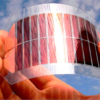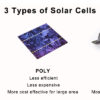PV industry chain: serious price divergence between upstream and downstream, PV silicon prices to remain high in 2021
According to the price data published by PV Infolink, the overall price of the PV industry chain showed an upward trend in 2021, but the price of different links varied greatly. 2021 March onwards, the price of PV silicon material gradually rose, with the price of dense material rising from 83,000 yuan/tonne at the beginning of the year to 230,000 yuan/tonne on 29 December, an increase of 177%. Solar wafer prices rose second, reaching 54%, while solar cell and photovoltaic module prices rose only 13% during the same period, photovoltaic silicon prices rose significantly higher compared with other links.
Photovoltaic silicon: supply and demand is still tight, prices remain high
At present, major PV silicon manufacturers such as China’s GCL, Daquan, etc. have been full of expansion plans, global polysilicon production capacity is expected to reach 1.139 million tons at the end of 2022. However, due to the expansion cycle and capacity creep factors, new projects are difficult to fully put into production in 2022, according to the full ideal creep situation is estimated in 2022 global effective capacity of 900,000 tons, 2022 PV silicon effective capacity will be able to support the monocrystalline PV wafer capacity of about 270GW. Prices may continue to remain high.
Photovoltaic silicon: the leading expansion cost advantage is obvious, the performance is expected to grow rapidly
In view of the long PV silicon expansion cycle, 22 years of planning capacity is difficult to all land, is expected to maintain a tight balance of PV silicon in 22 years, the price decline in space is limited. At the same time, China Tongwei, Daquan and other leading PV silicon expansion cost advantage is significant, the full cost is lower than the second and third line manufacturers more than 20%, and the new production line cost is lower, and hopefully in 2022H1 leading production, is expected to accelerate the release of performance in 2022 PV silicon is still in short supply in the background.
Solar silicon wafers: manufacturers full of expansion plans, gross margins will decline
According to incomplete statistics, the end of 2021 market PV wafer manufacturers combined production capacity of at least 350GW, the current year expansion capacity of close to 140GW. 2021 PV wafer production capacity than PV silicon obvious surplus, but due to the supply of PV silicon material is limited, coupled with the production of inventory gains, so 2021 PV wafer industry overall gross margin level is relatively high. However, in 2022, as each PV wafer new expansion projects gradually put into production, wafer year-end production capacity is expected to reach 509GW, its supply and silicon material will be loose compared to the high gross profit will decline.
Solar cells: the competitive landscape is relatively fragmented, the gap between first- and second-line manufacturers is rapidly widening
The current solar cell industry is relatively fragmented competitive landscape, in 2020 the CR5 enterprises combined production capacity of 53%, although in recent years the trend of concentration, but the industry concentration is still lower than other parts of the industry chain. 2021, the impact of both upstream and downstream squeeze, solar cell profitability space decline, part of the second and third-line enterprises due to the difficulty of access to solar silicon wafers, the start-up rate is low there are enterprises choose to production stop. The first-line solar cell manufacturers due to strong supply chain management capabilities and cost advantages, the start-up rate is relatively high, but the overall profit situation is still poor.
Photovoltaic modules: new technologies hold promise for further reductions in electricity costs
As PV modules approach the 210mm+ limit, further increases in size may lead to increased deformation during mechanical load testing, reduced resistance to extreme temperatures and increased transport difficulties, making it necessary to develop N-cell technology with higher conversion efficiency limits. According to the system value and cost per kWh calculations published by DNV GL in February 2021, a typical Japanese PV plant project, for example, increases in PV module power can effectively reduce BOS and LCOE costs when the module size remains the same. For a 210mm PV module, the BOS and LCOE costs will be reduced by 0.7 and 0.5 pct respectively when the power is increased from 545W to 600W.
Inverter: China’s inverter shipments grow steadily, overseas market share has improved
According to the General Administration of Customs of China, China’s inverter exports showed a steady growth in both quantity and value from 2017 to October 2021. According to the global inverter shipment ranking published by Wood Mackenzie in previous years, China Huawei and Sunshine Power have steadily ranked among the top two for many years. Meanwhile, Chinese companies have been pouring into the CR10 manufacturers since 2017, and inverter newcomers such as Goodway, Jinlang and Shangneng Electric are accelerating to catch up, with the hope of boosting overseas market share in the future by virtue of cost and price advantages.
Glass: Demand for thin glass continues to grow, and high-quality companies will benefit
According to PV Infolink statistics, the penetration rate of bifacial PV modules has increased rapidly in recent years, and the market share is likely to reach half in 2024. Considering that bifacial PV modules often require lighter and thinner glass, the demand for thin glass will continue to grow in the future. In addition, the big base project and BIPV also in the increase in demand for glass at the same time, require glass thickness thinner, more light transmission, but also can be both beautiful and other advantages, thus we expect Follett, Xinyi, Amadon and other high-quality manufacturers with ultra-thin glass processing capabilities will benefit in the long term.
Film: EVA particle expansion cycle is long, the supply is relatively tight
The EVA particles are the main raw material for photovoltaic film, and since September 2021, EVA particle manufacturers have experienced a decline in their production rates due to the impact of energy consumption restrictions, which has driven up particle prices. PV grade EVA as the main raw material for film, there are only three enterprises in China, namely Searborn, Lianhong and Ningbo Formosa Plastics can supply in bulk, and there is a long expansion cycle, high production barriers, from the start to production often takes more than three years. According to estimates, if the new PV installation of 2.26GW in 2022, in the case of the capacity ratio of 1.2, the corresponding EVA particle demand will be about 1.083 million tons, while the 2022 PV grade EVA particle production capacity is expected to be 1.024 million tons, so it is expected that EVA particles in 2022 will maintain a relatively tight state.
Stents: large base projects to start, tracking bracket penetration will increase
Tracking brackets are mainly used in centralised ground power stations, which can provide a certain amount of power generation gain compared to fixed brackets, thus improving the yield of power generation systems. Since 2015, the global penetration rate of tracking brackets has increased rapidly, and the market share is expected to be about 53% in 2022, with the market size reaching US$3.156 billion. However, the penetration rate of tracking brackets in the Chinese market is still low, with only 16% in 2019 according to CPIA, and there is still much room for improvement in the future. Under the trend of electricity price increase, owners will be less sensitive to the price of the bracket in order to obtain more power generation gain, which will help the tracking bracket penetration rate to increase.
The PV industry is entering a golden track under the continuous policy catalyst
Carbon neutrality has become a global consensus
According to the Energy and Climate Institute (ECIU), by October 2021, 132 countries and regions around the world have proposed carbon neutrality targets. Among them, Suriname and Bhutan have already achieved carbon neutrality, 13 countries, including Germany, have legislated on carbon neutrality, the EU and three other countries are proposing to legislate, and 53 other countries have officially announced their carbon neutrality timeline.
Photovoltaic power generation is more competitive and is the main force in achieving carbon neutrality
Renewable energy sources mainly include photovoltaic, wind power, hydropower, nuclear power and biomass, among which hydropower and biomass have limited development potential, while nuclear power cannot be widely used due to geographical and safety factors. Therefore, among the various types of renewable power sources, only photovoltaic and wind power have a high potential for development and are suitable for large-scale development.
Globally, a number of countries have issued incentives for a variety of renewable power sources, including photovoltaics, mainly in the form of tariff subsidies, power offsets and investment subsidies, with the main aim of promoting the share of renewable energy generation.
Short-term demand outlook: global new installations are expected to reach 226GW in 2022
From a comprehensive perspective, the global PV new installation scale is expected to reach 226GW in 2022, of which major markets such as China, Europe and the US will grow significantly in 2022, and other high-potential regions such as India and the Middle East are also expected to bring incremental growth.
Following such confusing times, people often find themselves locked up in a dilemma on the decision of installing the appropriate PV module for their homes, offices, etc. And for that very reason, we are here ready to assist you in whatever you need. Contact us now at Whatsapp: +86 159 2091 1832 and get a quote.



